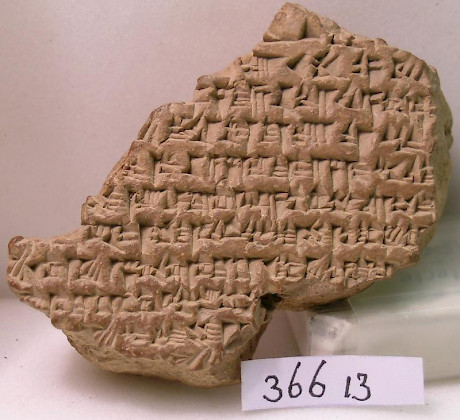BCHP 4 (Alexander and Artaxerxes Fragment)
The Fragment referring to Alexander the Great and an Artaxerxes is one of the Mesopotamian chronicles written in ancient Babylonia in the Hellenistic Period. It is highly enigmatic, but clearly refers to events after the Macedonian conquest.

According to the Greek historian Arrian of Nicomedia, Alexander the Great ordered (during his first visit to Babylon in 331 BC) that the Esagila, the great temple dedicated to the Babylonian supreme god Marduk, and the Etemenanki, the large temple tower next to it, were to be rebuilt. When the Macedonian conqueror returned to the ancient city in 323, he noted that not much work had been done yet (more), and gave new instructions to both the citizens and his own soldiers.
Arrian's statement may be confirmed by the following cuneiform text, known as BM 36613. Unfortunately, the text is not only badly damaged, it is not very clear either.
On this webpage, a new reading is proposed; the official publication will be in I.L. Finkel, R.J. van der Spek, R. Pirngruber, Babylonian Chronographic Texts from the Hellenistic Period (2020; = BCHP; Writings of the Ancient World).
General commentary
Unfortunately this text is very enigmatic. In the first place, it is unclear what kind of text it is. It may be a chronicle or part of an Astronomical Diary. In that case a quotation from a letter or address is preserved, which contents may be in lines 8'-10'. It is also possible that the entire text is a proclamation or letter to the Babylonians ("you Babylonians" (l. 8'), in which mention is made of some facts of history of the days of an Arses and of Alexander the Great regarding temples and houses.
The document may have been written at the time of the march of Alexander the Great towards Babylon after the battle of Gaugamela in 331 BC or refer to his return in 323 BC.
The tablet can also date to a later period. One option is that it was written at the time of the restorations of Esagila and Ezida by Seleucus I Nicator and Antiochus I Soter (Kuhrt, Sherwin-White 1991), and that earlier work by the great Alexander was remembered: the fact that the troops of Alexander had removed the rubble of Esagila, that he had promised to return houses to the possessions of the temple and the Babylonians.note The crown prince Antiochus, son of Seleucus I, figures in the Ruin of Esagila Chronicle (BCHP 6), a chronicle which describes the offerings made by the crown prince on the ruin of Esagila and his effort to remove the rubble of Esagila with the help of troops, wagons and elephants.
All earlier editors (including Van der Spek 2003) of this text have assumed that the "Arses, son of Ochos, who is called Artaxerxes", mentioned in line 6', is the Achaemenid king Arses, son of Artaxerxes III Ochus(r.338-336 BCE). It cannot be excluded that it refers to Artaxerxes II Mnemon (r.404-358 BCE).
Alexander restores the Esagila
[1] [illegible]
[2] ........................... the enemy with fire ..................
[3] .................. and the troops ..................
[4] .................. iron of his own hands the debris from the wall of .........
[5] .................. were removed. On that day [nth] .........
[6] [month ? year x]th of Arses, son of Ochus, who is called Artaxerxes
[7] [some people of some houses] entered the temple of Anunitu inside the city of Sippar
[8] ......... for Alexander, the king, they were mourning. You Babylonians
[9] ......... [verb] The [lacuna] and the houses to the possession of Esagila and the Babylonians returned
[10] .................. Esagila they will rebuild. The army ..................
[11] .................. few troops ....................................
[12] [broken off]